Nursing Case Scenario: Diverse Health Challenges and Nursing Actions
VerifiedAdded on 2023/06/03
|23
|4859
|459
Case Study
AI Summary
This nursing case scenario provides a comprehensive overview of various patient care situations and healthcare interventions. It begins with a scenario involving a child with eczema and a single mother, addressing biological, biomedical, and behavioral aspects of the child's health. It further discusses primary healthcare and socio-economic factors affecting the child's well-being, proposing support from maternal and child welfare agencies. The document outlines the roles of different healthcare professionals such as occupational health nurses, community nurses, school nurses, and Aboriginal health workers. Additionally, it examines the health challenges faced by Aboriginal communities due to water contamination, emphasizing the need for policy changes and community awareness. The case study extends to common health issues across different age groups, from infants to older adults, and delves into a scenario involving a patient with angina, highlighting the importance of biological and social factors in health management. Desklib offers similar solved assignments and study tools for students.
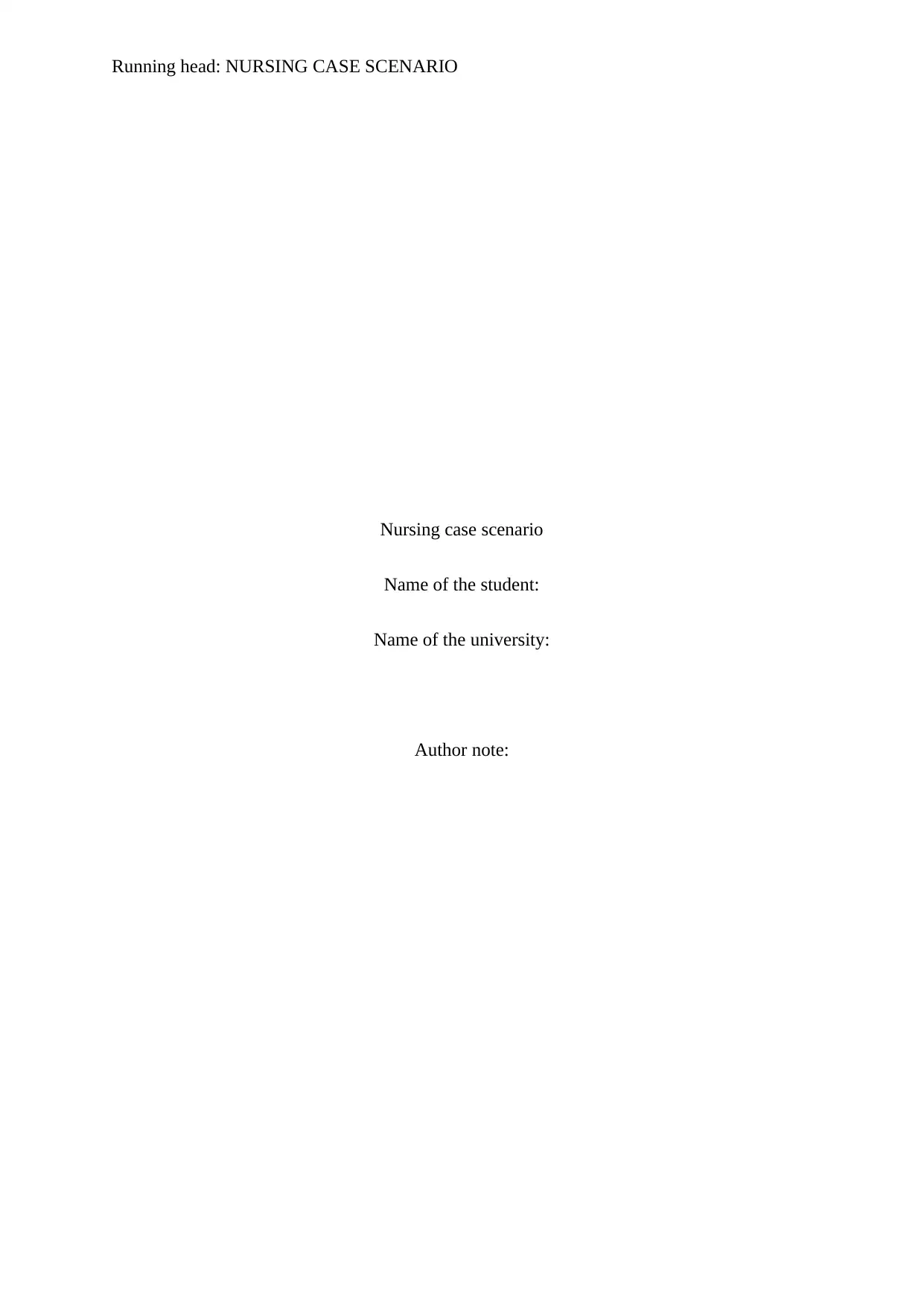
Running head: NURSING CASE SCENARIO
Nursing case scenario
Name of the student:
Name of the university:
Author note:
Nursing case scenario
Name of the student:
Name of the university:
Author note:
Paraphrase This Document
Need a fresh take? Get an instant paraphrase of this document with our AI Paraphraser
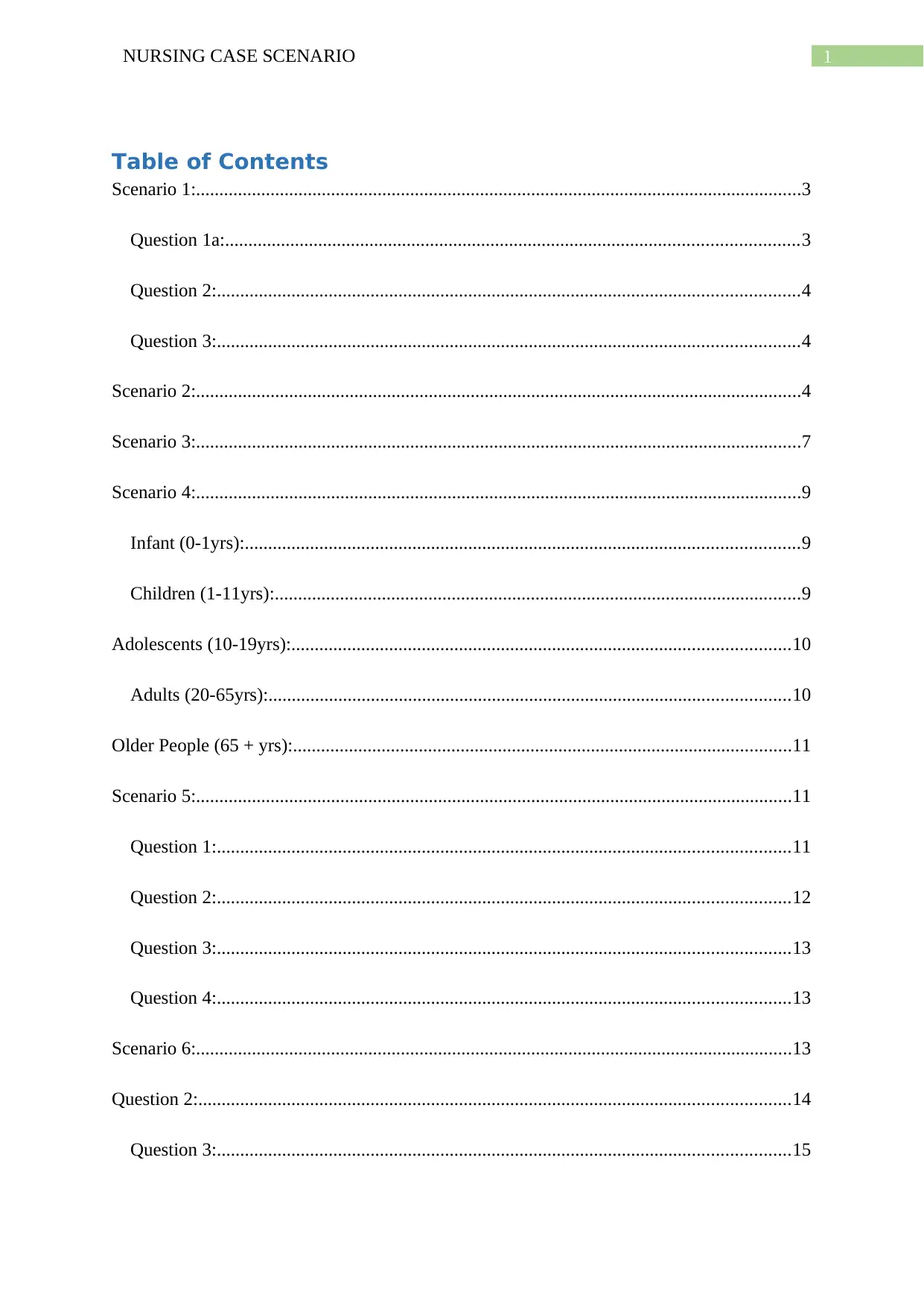
1NURSING CASE SCENARIO
Table of Contents
Scenario 1:..................................................................................................................................3
Question 1a:...........................................................................................................................3
Question 2:.............................................................................................................................4
Question 3:.............................................................................................................................4
Scenario 2:..................................................................................................................................4
Scenario 3:..................................................................................................................................7
Scenario 4:..................................................................................................................................9
Infant (0-1yrs):.......................................................................................................................9
Children (1-11yrs):.................................................................................................................9
Adolescents (10-19yrs):...........................................................................................................10
Adults (20-65yrs):................................................................................................................10
Older People (65 + yrs):...........................................................................................................11
Scenario 5:................................................................................................................................11
Question 1:...........................................................................................................................11
Question 2:...........................................................................................................................12
Question 3:...........................................................................................................................13
Question 4:...........................................................................................................................13
Scenario 6:................................................................................................................................13
Question 2:...............................................................................................................................14
Question 3:...........................................................................................................................15
Table of Contents
Scenario 1:..................................................................................................................................3
Question 1a:...........................................................................................................................3
Question 2:.............................................................................................................................4
Question 3:.............................................................................................................................4
Scenario 2:..................................................................................................................................4
Scenario 3:..................................................................................................................................7
Scenario 4:..................................................................................................................................9
Infant (0-1yrs):.......................................................................................................................9
Children (1-11yrs):.................................................................................................................9
Adolescents (10-19yrs):...........................................................................................................10
Adults (20-65yrs):................................................................................................................10
Older People (65 + yrs):...........................................................................................................11
Scenario 5:................................................................................................................................11
Question 1:...........................................................................................................................11
Question 2:...........................................................................................................................12
Question 3:...........................................................................................................................13
Question 4:...........................................................................................................................13
Scenario 6:................................................................................................................................13
Question 2:...............................................................................................................................14
Question 3:...........................................................................................................................15
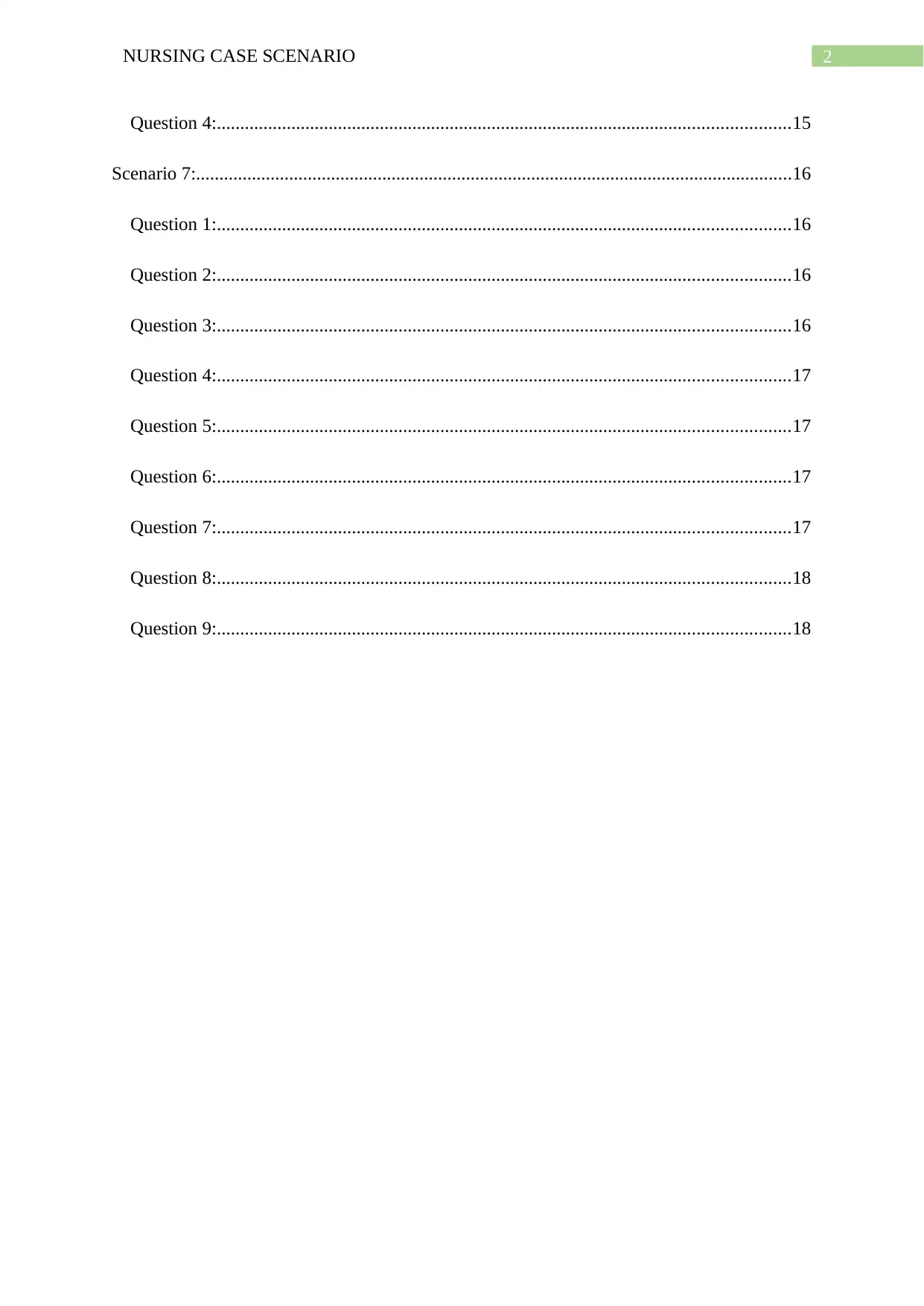
2NURSING CASE SCENARIO
Question 4:...........................................................................................................................15
Scenario 7:................................................................................................................................16
Question 1:...........................................................................................................................16
Question 2:...........................................................................................................................16
Question 3:...........................................................................................................................16
Question 4:...........................................................................................................................17
Question 5:...........................................................................................................................17
Question 6:...........................................................................................................................17
Question 7:...........................................................................................................................17
Question 8:...........................................................................................................................18
Question 9:...........................................................................................................................18
Question 4:...........................................................................................................................15
Scenario 7:................................................................................................................................16
Question 1:...........................................................................................................................16
Question 2:...........................................................................................................................16
Question 3:...........................................................................................................................16
Question 4:...........................................................................................................................17
Question 5:...........................................................................................................................17
Question 6:...........................................................................................................................17
Question 7:...........................................................................................................................17
Question 8:...........................................................................................................................18
Question 9:...........................................................................................................................18
⊘ This is a preview!⊘
Do you want full access?
Subscribe today to unlock all pages.

Trusted by 1+ million students worldwide
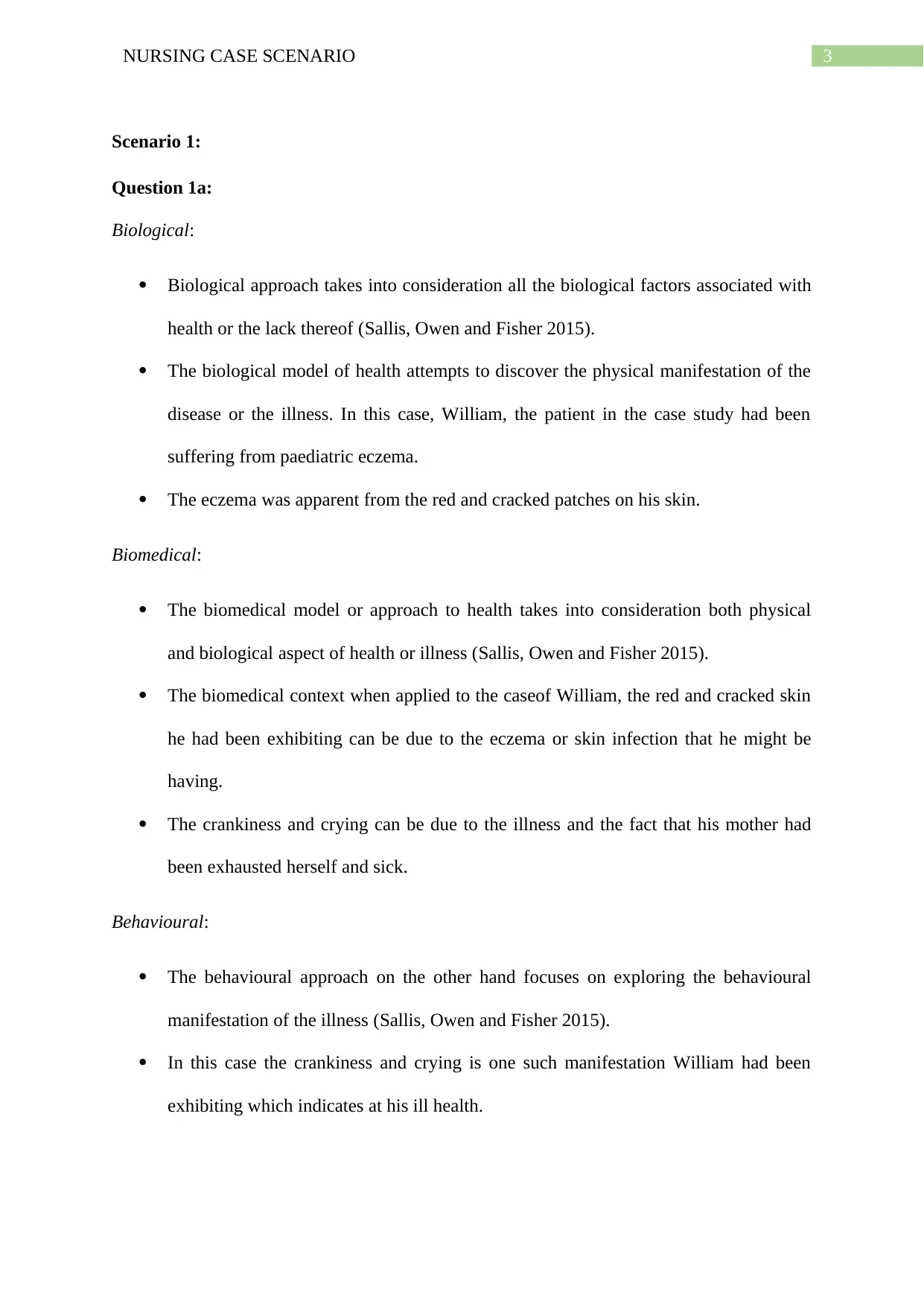
3NURSING CASE SCENARIO
Scenario 1:
Question 1a:
Biological:
Biological approach takes into consideration all the biological factors associated with
health or the lack thereof (Sallis, Owen and Fisher 2015).
The biological model of health attempts to discover the physical manifestation of the
disease or the illness. In this case, William, the patient in the case study had been
suffering from paediatric eczema.
The eczema was apparent from the red and cracked patches on his skin.
Biomedical:
The biomedical model or approach to health takes into consideration both physical
and biological aspect of health or illness (Sallis, Owen and Fisher 2015).
The biomedical context when applied to the caseof William, the red and cracked skin
he had been exhibiting can be due to the eczema or skin infection that he might be
having.
The crankiness and crying can be due to the illness and the fact that his mother had
been exhausted herself and sick.
Behavioural:
The behavioural approach on the other hand focuses on exploring the behavioural
manifestation of the illness (Sallis, Owen and Fisher 2015).
In this case the crankiness and crying is one such manifestation William had been
exhibiting which indicates at his ill health.
Scenario 1:
Question 1a:
Biological:
Biological approach takes into consideration all the biological factors associated with
health or the lack thereof (Sallis, Owen and Fisher 2015).
The biological model of health attempts to discover the physical manifestation of the
disease or the illness. In this case, William, the patient in the case study had been
suffering from paediatric eczema.
The eczema was apparent from the red and cracked patches on his skin.
Biomedical:
The biomedical model or approach to health takes into consideration both physical
and biological aspect of health or illness (Sallis, Owen and Fisher 2015).
The biomedical context when applied to the caseof William, the red and cracked skin
he had been exhibiting can be due to the eczema or skin infection that he might be
having.
The crankiness and crying can be due to the illness and the fact that his mother had
been exhausted herself and sick.
Behavioural:
The behavioural approach on the other hand focuses on exploring the behavioural
manifestation of the illness (Sallis, Owen and Fisher 2015).
In this case the crankiness and crying is one such manifestation William had been
exhibiting which indicates at his ill health.
Paraphrase This Document
Need a fresh take? Get an instant paraphrase of this document with our AI Paraphraser
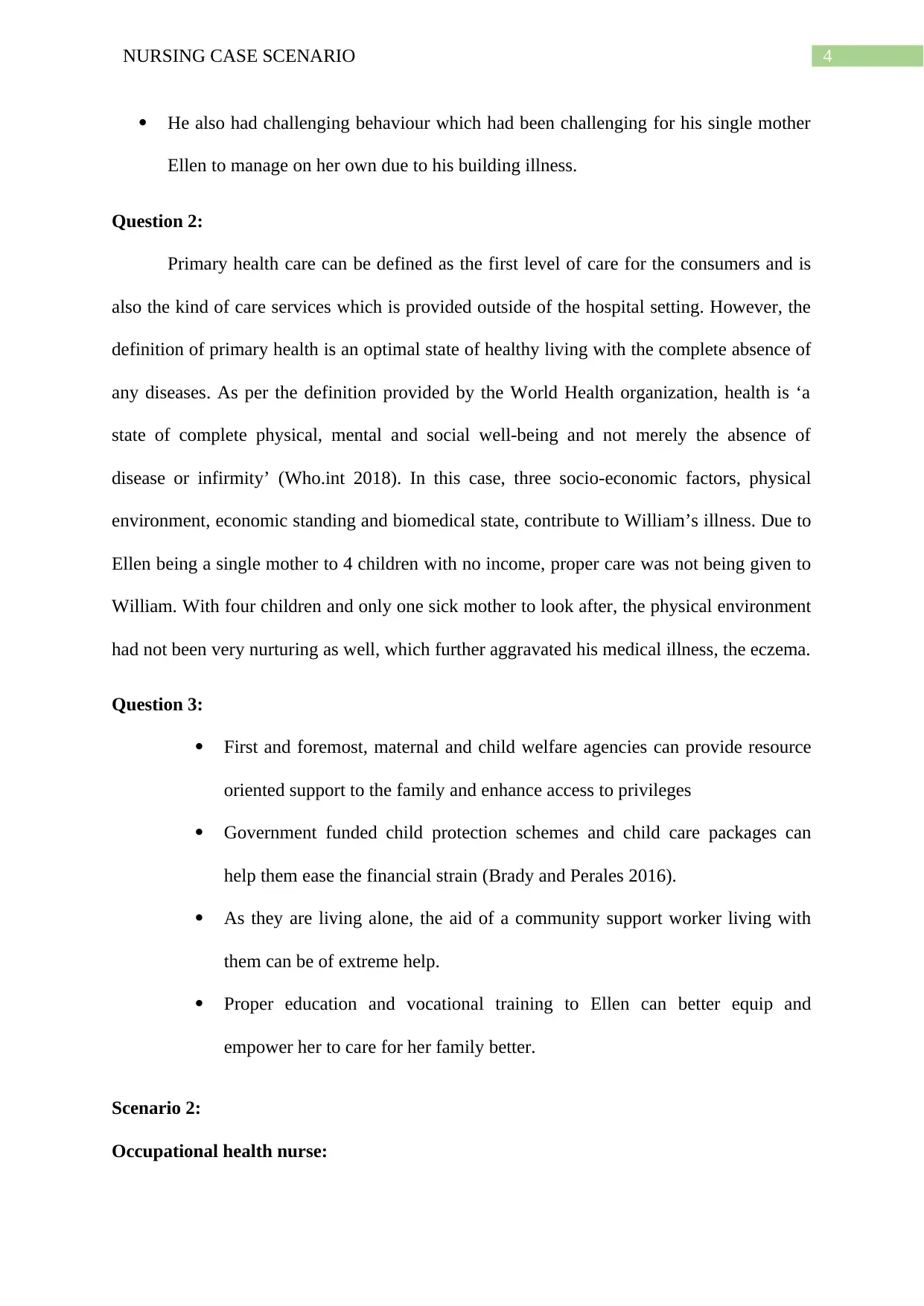
4NURSING CASE SCENARIO
He also had challenging behaviour which had been challenging for his single mother
Ellen to manage on her own due to his building illness.
Question 2:
Primary health care can be defined as the first level of care for the consumers and is
also the kind of care services which is provided outside of the hospital setting. However, the
definition of primary health is an optimal state of healthy living with the complete absence of
any diseases. As per the definition provided by the World Health organization, health is ‘a
state of complete physical, mental and social well-being and not merely the absence of
disease or infirmity’ (Who.int 2018). In this case, three socio-economic factors, physical
environment, economic standing and biomedical state, contribute to William’s illness. Due to
Ellen being a single mother to 4 children with no income, proper care was not being given to
William. With four children and only one sick mother to look after, the physical environment
had not been very nurturing as well, which further aggravated his medical illness, the eczema.
Question 3:
First and foremost, maternal and child welfare agencies can provide resource
oriented support to the family and enhance access to privileges
Government funded child protection schemes and child care packages can
help them ease the financial strain (Brady and Perales 2016).
As they are living alone, the aid of a community support worker living with
them can be of extreme help.
Proper education and vocational training to Ellen can better equip and
empower her to care for her family better.
Scenario 2:
Occupational health nurse:
He also had challenging behaviour which had been challenging for his single mother
Ellen to manage on her own due to his building illness.
Question 2:
Primary health care can be defined as the first level of care for the consumers and is
also the kind of care services which is provided outside of the hospital setting. However, the
definition of primary health is an optimal state of healthy living with the complete absence of
any diseases. As per the definition provided by the World Health organization, health is ‘a
state of complete physical, mental and social well-being and not merely the absence of
disease or infirmity’ (Who.int 2018). In this case, three socio-economic factors, physical
environment, economic standing and biomedical state, contribute to William’s illness. Due to
Ellen being a single mother to 4 children with no income, proper care was not being given to
William. With four children and only one sick mother to look after, the physical environment
had not been very nurturing as well, which further aggravated his medical illness, the eczema.
Question 3:
First and foremost, maternal and child welfare agencies can provide resource
oriented support to the family and enhance access to privileges
Government funded child protection schemes and child care packages can
help them ease the financial strain (Brady and Perales 2016).
As they are living alone, the aid of a community support worker living with
them can be of extreme help.
Proper education and vocational training to Ellen can better equip and
empower her to care for her family better.
Scenario 2:
Occupational health nurse:
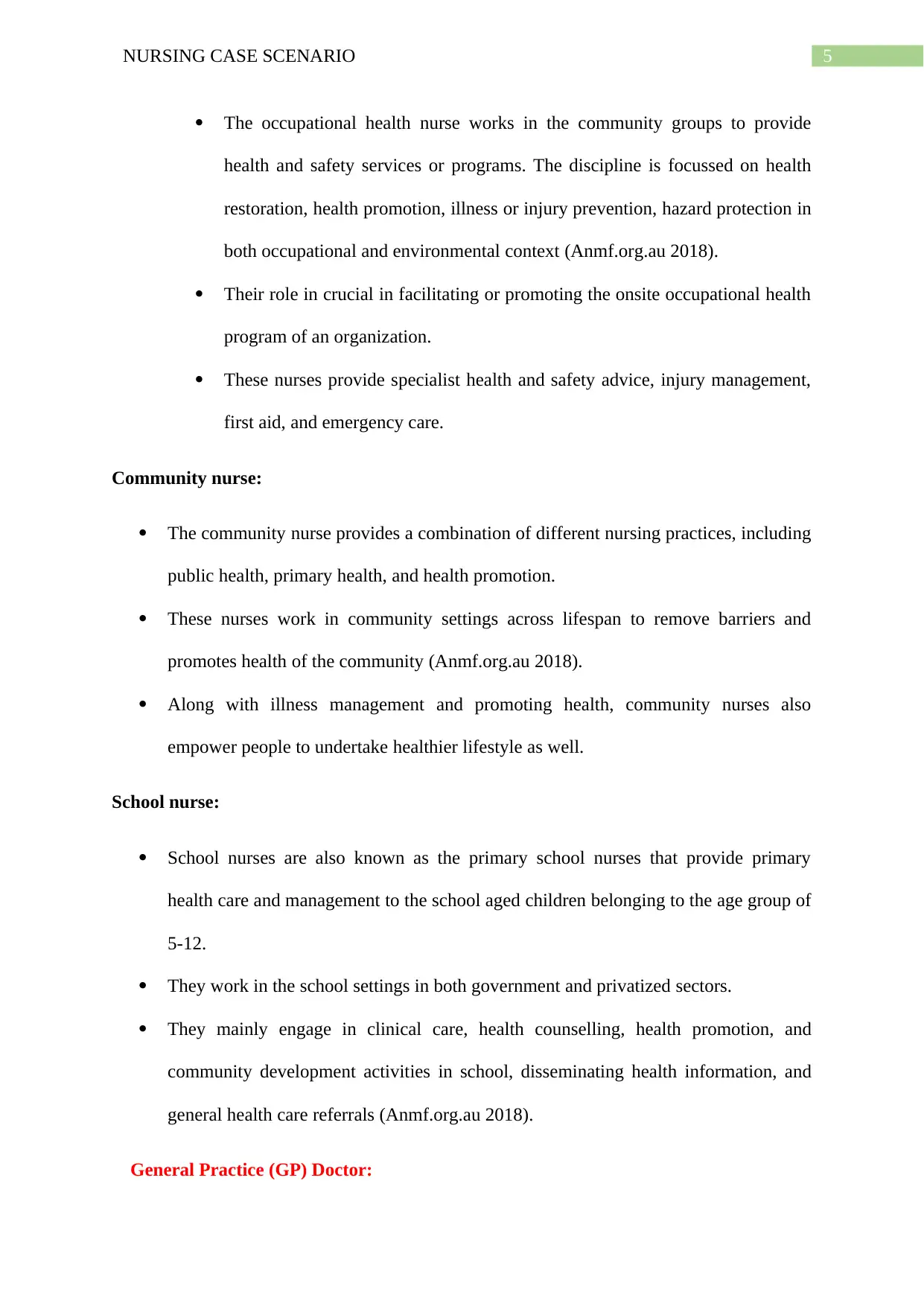
5NURSING CASE SCENARIO
The occupational health nurse works in the community groups to provide
health and safety services or programs. The discipline is focussed on health
restoration, health promotion, illness or injury prevention, hazard protection in
both occupational and environmental context (Anmf.org.au 2018).
Their role in crucial in facilitating or promoting the onsite occupational health
program of an organization.
These nurses provide specialist health and safety advice, injury management,
first aid, and emergency care.
Community nurse:
The community nurse provides a combination of different nursing practices, including
public health, primary health, and health promotion.
These nurses work in community settings across lifespan to remove barriers and
promotes health of the community (Anmf.org.au 2018).
Along with illness management and promoting health, community nurses also
empower people to undertake healthier lifestyle as well.
School nurse:
School nurses are also known as the primary school nurses that provide primary
health care and management to the school aged children belonging to the age group of
5-12.
They work in the school settings in both government and privatized sectors.
They mainly engage in clinical care, health counselling, health promotion, and
community development activities in school, disseminating health information, and
general health care referrals (Anmf.org.au 2018).
General Practice (GP) Doctor:
The occupational health nurse works in the community groups to provide
health and safety services or programs. The discipline is focussed on health
restoration, health promotion, illness or injury prevention, hazard protection in
both occupational and environmental context (Anmf.org.au 2018).
Their role in crucial in facilitating or promoting the onsite occupational health
program of an organization.
These nurses provide specialist health and safety advice, injury management,
first aid, and emergency care.
Community nurse:
The community nurse provides a combination of different nursing practices, including
public health, primary health, and health promotion.
These nurses work in community settings across lifespan to remove barriers and
promotes health of the community (Anmf.org.au 2018).
Along with illness management and promoting health, community nurses also
empower people to undertake healthier lifestyle as well.
School nurse:
School nurses are also known as the primary school nurses that provide primary
health care and management to the school aged children belonging to the age group of
5-12.
They work in the school settings in both government and privatized sectors.
They mainly engage in clinical care, health counselling, health promotion, and
community development activities in school, disseminating health information, and
general health care referrals (Anmf.org.au 2018).
General Practice (GP) Doctor:
⊘ This is a preview!⊘
Do you want full access?
Subscribe today to unlock all pages.

Trusted by 1+ million students worldwide
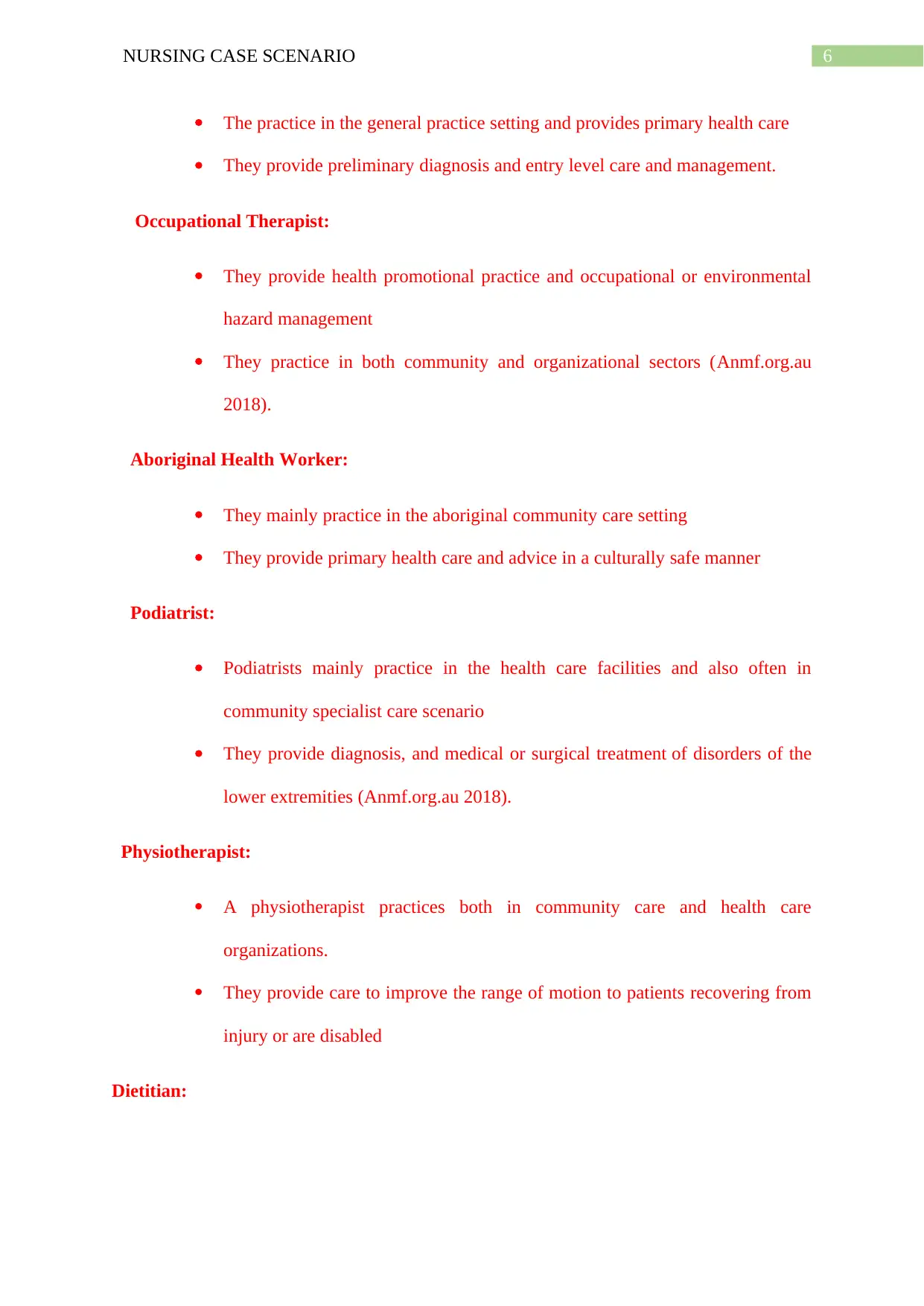
6NURSING CASE SCENARIO
The practice in the general practice setting and provides primary health care
They provide preliminary diagnosis and entry level care and management.
Occupational Therapist:
They provide health promotional practice and occupational or environmental
hazard management
They practice in both community and organizational sectors (Anmf.org.au
2018).
Aboriginal Health Worker:
They mainly practice in the aboriginal community care setting
They provide primary health care and advice in a culturally safe manner
Podiatrist:
Podiatrists mainly practice in the health care facilities and also often in
community specialist care scenario
They provide diagnosis, and medical or surgical treatment of disorders of the
lower extremities (Anmf.org.au 2018).
Physiotherapist:
A physiotherapist practices both in community care and health care
organizations.
They provide care to improve the range of motion to patients recovering from
injury or are disabled
Dietitian:
The practice in the general practice setting and provides primary health care
They provide preliminary diagnosis and entry level care and management.
Occupational Therapist:
They provide health promotional practice and occupational or environmental
hazard management
They practice in both community and organizational sectors (Anmf.org.au
2018).
Aboriginal Health Worker:
They mainly practice in the aboriginal community care setting
They provide primary health care and advice in a culturally safe manner
Podiatrist:
Podiatrists mainly practice in the health care facilities and also often in
community specialist care scenario
They provide diagnosis, and medical or surgical treatment of disorders of the
lower extremities (Anmf.org.au 2018).
Physiotherapist:
A physiotherapist practices both in community care and health care
organizations.
They provide care to improve the range of motion to patients recovering from
injury or are disabled
Dietitian:
Paraphrase This Document
Need a fresh take? Get an instant paraphrase of this document with our AI Paraphraser

7NURSING CASE SCENARIO
They are an integral part of the health care industry and they practice in
community and general practice setting
They provide nutritional advice and help in dietary habit change (Anmf.org.au
2018).
Interpreter:
They practice in the aboriginal or culturally diverse practice
They provide assistance as cultural liaison for aboriginal and native patient
with language barrier
Social Worker:
They mainly practice in the community setting ‘
They engage in providing emotional, psycho-social and financial support
Dentist:
They practice in both community and health care organization setting
They provide primary, secondary and even tertiary care in oral health issues
(Anmf.org.au 2018).
Psychologist:
They practice in both community and health organization setting
They provide mental, emotional and cultural support
Scenario 3:
The community demographics that I have chosen for this particular scenario is the
aboriginal communities living in the rural and coastal parts of Australia. There is mounting
evidence that suggests that the disparities in the health status and the life expectancy of these
They are an integral part of the health care industry and they practice in
community and general practice setting
They provide nutritional advice and help in dietary habit change (Anmf.org.au
2018).
Interpreter:
They practice in the aboriginal or culturally diverse practice
They provide assistance as cultural liaison for aboriginal and native patient
with language barrier
Social Worker:
They mainly practice in the community setting ‘
They engage in providing emotional, psycho-social and financial support
Dentist:
They practice in both community and health care organization setting
They provide primary, secondary and even tertiary care in oral health issues
(Anmf.org.au 2018).
Psychologist:
They practice in both community and health organization setting
They provide mental, emotional and cultural support
Scenario 3:
The community demographics that I have chosen for this particular scenario is the
aboriginal communities living in the rural and coastal parts of Australia. There is mounting
evidence that suggests that the disparities in the health status and the life expectancy of these
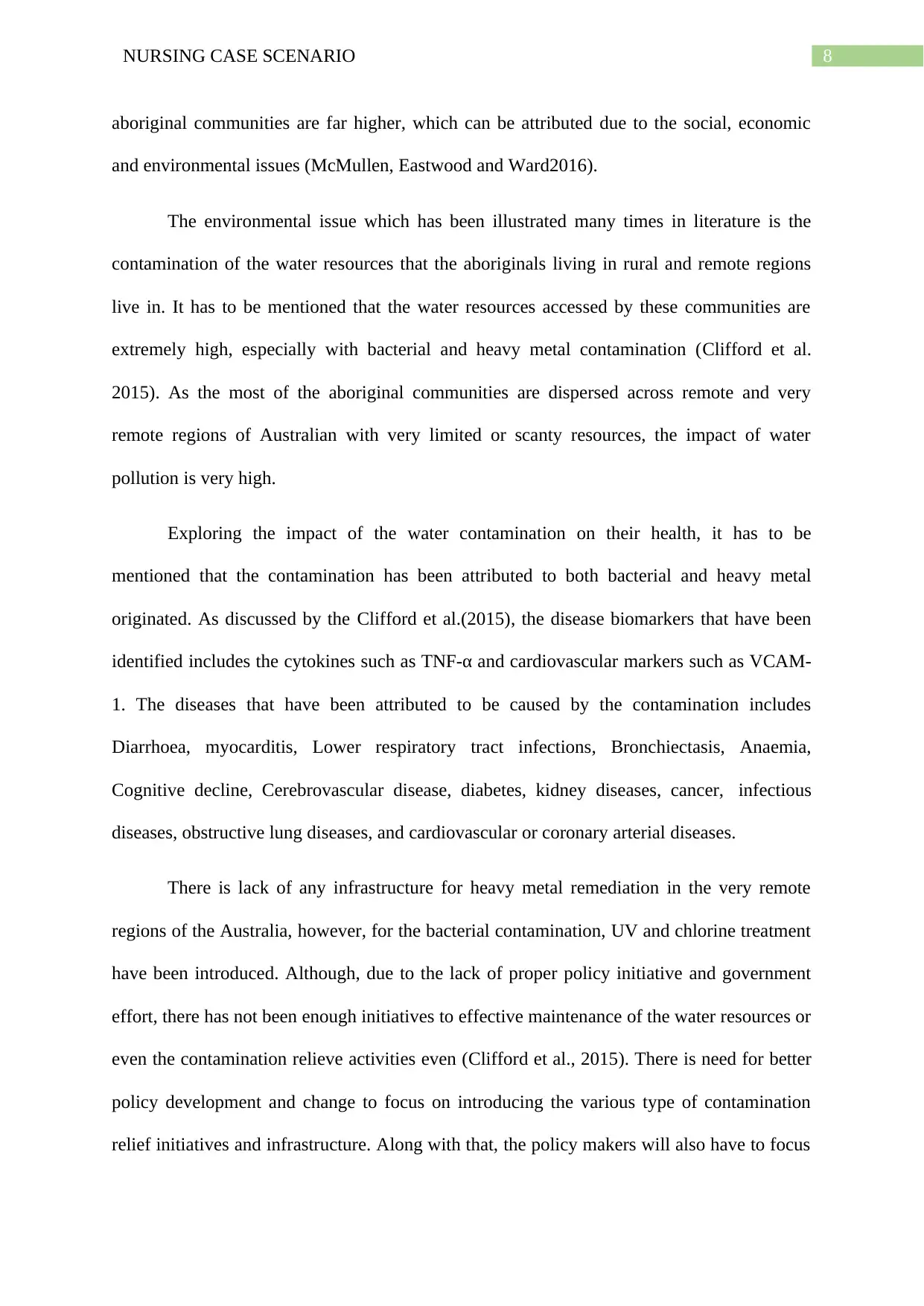
8NURSING CASE SCENARIO
aboriginal communities are far higher, which can be attributed due to the social, economic
and environmental issues (McMullen, Eastwood and Ward2016).
The environmental issue which has been illustrated many times in literature is the
contamination of the water resources that the aboriginals living in rural and remote regions
live in. It has to be mentioned that the water resources accessed by these communities are
extremely high, especially with bacterial and heavy metal contamination (Clifford et al.
2015). As the most of the aboriginal communities are dispersed across remote and very
remote regions of Australian with very limited or scanty resources, the impact of water
pollution is very high.
Exploring the impact of the water contamination on their health, it has to be
mentioned that the contamination has been attributed to both bacterial and heavy metal
originated. As discussed by the Clifford et al.(2015), the disease biomarkers that have been
identified includes the cytokines such as TNF-α and cardiovascular markers such as VCAM-
1. The diseases that have been attributed to be caused by the contamination includes
Diarrhoea, myocarditis, Lower respiratory tract infections, Bronchiectasis, Anaemia,
Cognitive decline, Cerebrovascular disease, diabetes, kidney diseases, cancer, infectious
diseases, obstructive lung diseases, and cardiovascular or coronary arterial diseases.
There is lack of any infrastructure for heavy metal remediation in the very remote
regions of the Australia, however, for the bacterial contamination, UV and chlorine treatment
have been introduced. Although, due to the lack of proper policy initiative and government
effort, there has not been enough initiatives to effective maintenance of the water resources or
even the contamination relieve activities even (Clifford et al., 2015). There is need for better
policy development and change to focus on introducing the various type of contamination
relief initiatives and infrastructure. Along with that, the policy makers will also have to focus
aboriginal communities are far higher, which can be attributed due to the social, economic
and environmental issues (McMullen, Eastwood and Ward2016).
The environmental issue which has been illustrated many times in literature is the
contamination of the water resources that the aboriginals living in rural and remote regions
live in. It has to be mentioned that the water resources accessed by these communities are
extremely high, especially with bacterial and heavy metal contamination (Clifford et al.
2015). As the most of the aboriginal communities are dispersed across remote and very
remote regions of Australian with very limited or scanty resources, the impact of water
pollution is very high.
Exploring the impact of the water contamination on their health, it has to be
mentioned that the contamination has been attributed to both bacterial and heavy metal
originated. As discussed by the Clifford et al.(2015), the disease biomarkers that have been
identified includes the cytokines such as TNF-α and cardiovascular markers such as VCAM-
1. The diseases that have been attributed to be caused by the contamination includes
Diarrhoea, myocarditis, Lower respiratory tract infections, Bronchiectasis, Anaemia,
Cognitive decline, Cerebrovascular disease, diabetes, kidney diseases, cancer, infectious
diseases, obstructive lung diseases, and cardiovascular or coronary arterial diseases.
There is lack of any infrastructure for heavy metal remediation in the very remote
regions of the Australia, however, for the bacterial contamination, UV and chlorine treatment
have been introduced. Although, due to the lack of proper policy initiative and government
effort, there has not been enough initiatives to effective maintenance of the water resources or
even the contamination relieve activities even (Clifford et al., 2015). There is need for better
policy development and change to focus on introducing the various type of contamination
relief initiatives and infrastructure. Along with that, the policy makers will also have to focus
⊘ This is a preview!⊘
Do you want full access?
Subscribe today to unlock all pages.

Trusted by 1+ million students worldwide
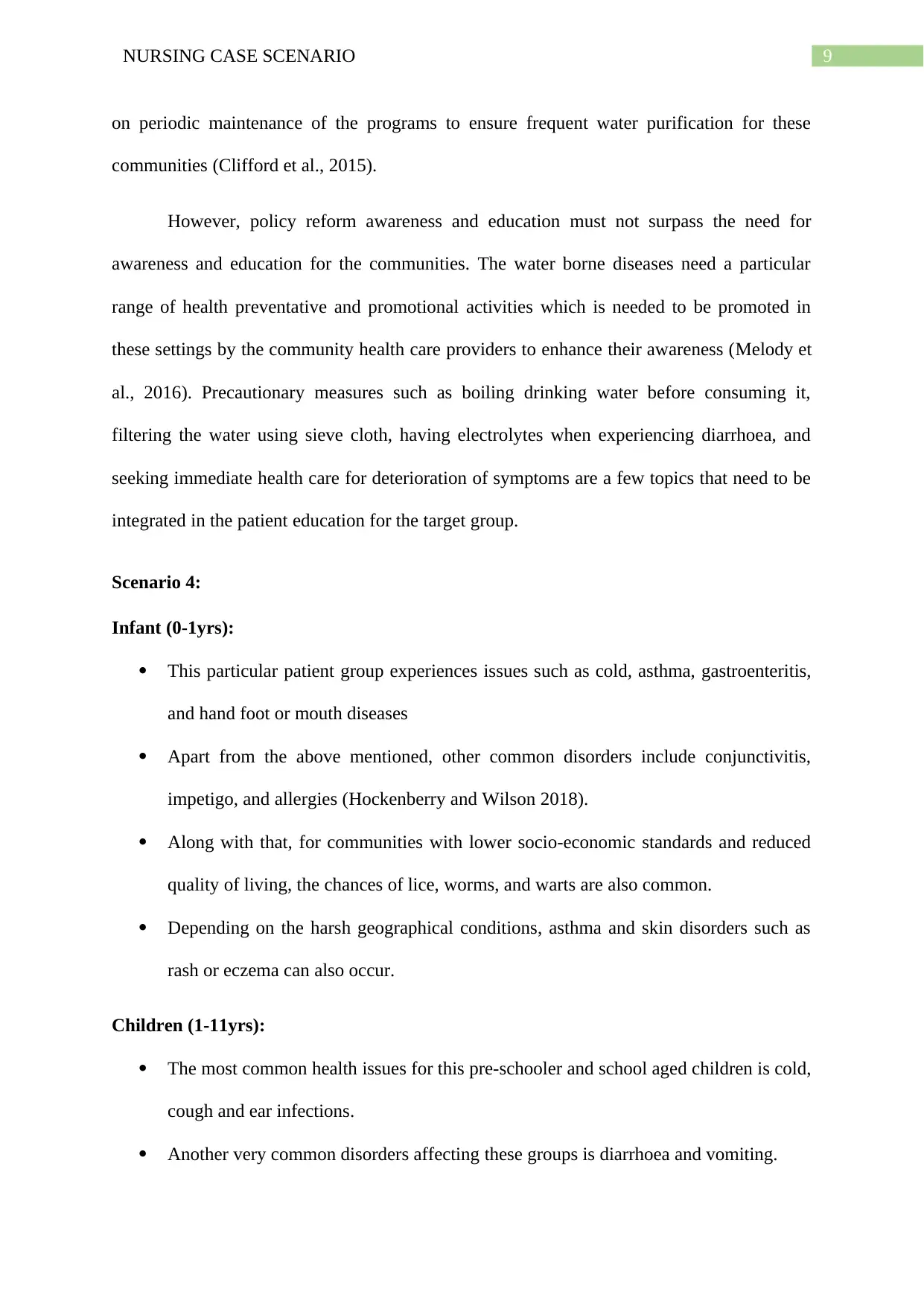
9NURSING CASE SCENARIO
on periodic maintenance of the programs to ensure frequent water purification for these
communities (Clifford et al., 2015).
However, policy reform awareness and education must not surpass the need for
awareness and education for the communities. The water borne diseases need a particular
range of health preventative and promotional activities which is needed to be promoted in
these settings by the community health care providers to enhance their awareness (Melody et
al., 2016). Precautionary measures such as boiling drinking water before consuming it,
filtering the water using sieve cloth, having electrolytes when experiencing diarrhoea, and
seeking immediate health care for deterioration of symptoms are a few topics that need to be
integrated in the patient education for the target group.
Scenario 4:
Infant (0-1yrs):
This particular patient group experiences issues such as cold, asthma, gastroenteritis,
and hand foot or mouth diseases
Apart from the above mentioned, other common disorders include conjunctivitis,
impetigo, and allergies (Hockenberry and Wilson 2018).
Along with that, for communities with lower socio-economic standards and reduced
quality of living, the chances of lice, worms, and warts are also common.
Depending on the harsh geographical conditions, asthma and skin disorders such as
rash or eczema can also occur.
Children (1-11yrs):
The most common health issues for this pre-schooler and school aged children is cold,
cough and ear infections.
Another very common disorders affecting these groups is diarrhoea and vomiting.
on periodic maintenance of the programs to ensure frequent water purification for these
communities (Clifford et al., 2015).
However, policy reform awareness and education must not surpass the need for
awareness and education for the communities. The water borne diseases need a particular
range of health preventative and promotional activities which is needed to be promoted in
these settings by the community health care providers to enhance their awareness (Melody et
al., 2016). Precautionary measures such as boiling drinking water before consuming it,
filtering the water using sieve cloth, having electrolytes when experiencing diarrhoea, and
seeking immediate health care for deterioration of symptoms are a few topics that need to be
integrated in the patient education for the target group.
Scenario 4:
Infant (0-1yrs):
This particular patient group experiences issues such as cold, asthma, gastroenteritis,
and hand foot or mouth diseases
Apart from the above mentioned, other common disorders include conjunctivitis,
impetigo, and allergies (Hockenberry and Wilson 2018).
Along with that, for communities with lower socio-economic standards and reduced
quality of living, the chances of lice, worms, and warts are also common.
Depending on the harsh geographical conditions, asthma and skin disorders such as
rash or eczema can also occur.
Children (1-11yrs):
The most common health issues for this pre-schooler and school aged children is cold,
cough and ear infections.
Another very common disorders affecting these groups is diarrhoea and vomiting.
Paraphrase This Document
Need a fresh take? Get an instant paraphrase of this document with our AI Paraphraser
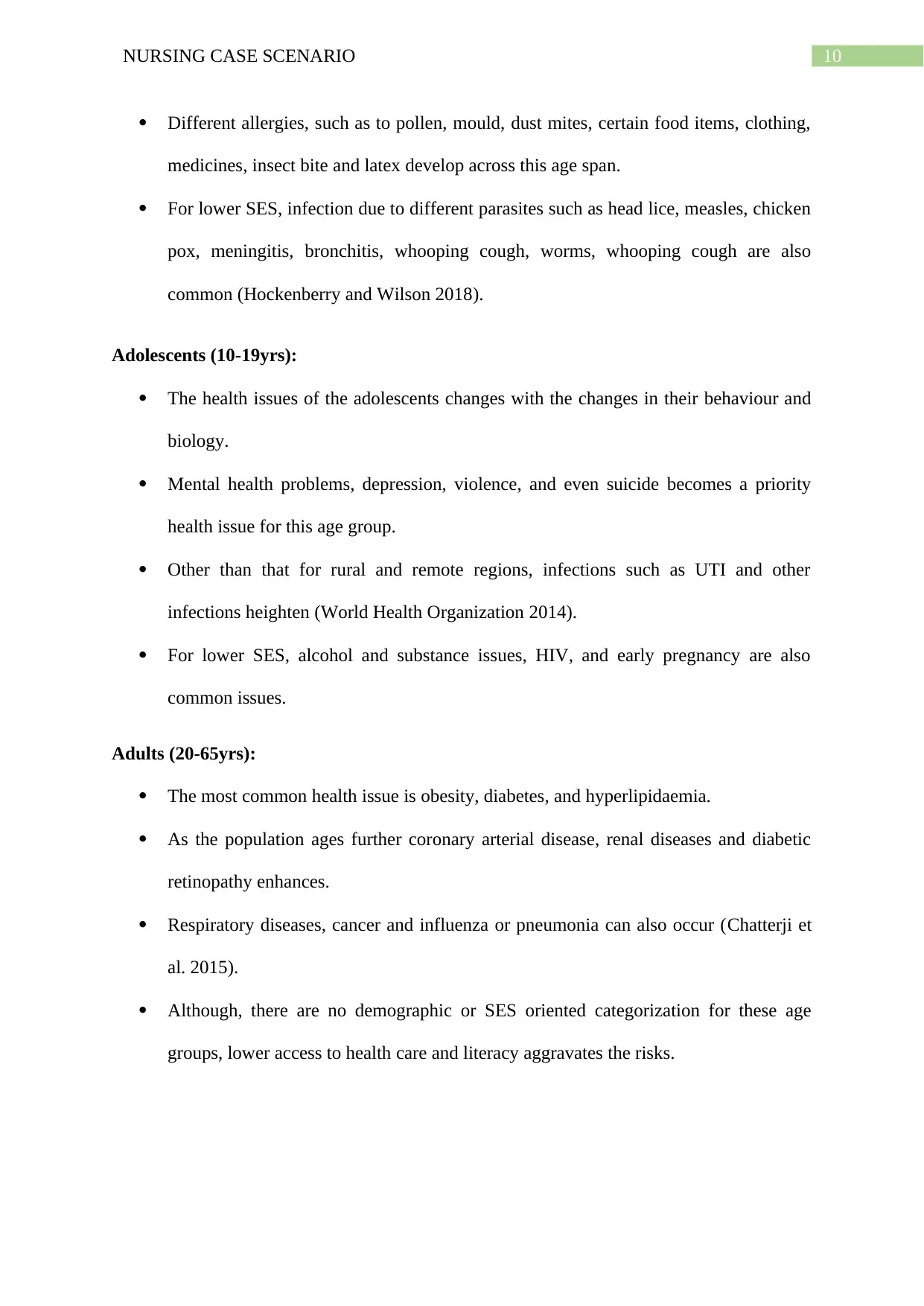
10NURSING CASE SCENARIO
Different allergies, such as to pollen, mould, dust mites, certain food items, clothing,
medicines, insect bite and latex develop across this age span.
For lower SES, infection due to different parasites such as head lice, measles, chicken
pox, meningitis, bronchitis, whooping cough, worms, whooping cough are also
common (Hockenberry and Wilson 2018).
Adolescents (10-19yrs):
The health issues of the adolescents changes with the changes in their behaviour and
biology.
Mental health problems, depression, violence, and even suicide becomes a priority
health issue for this age group.
Other than that for rural and remote regions, infections such as UTI and other
infections heighten (World Health Organization 2014).
For lower SES, alcohol and substance issues, HIV, and early pregnancy are also
common issues.
Adults (20-65yrs):
The most common health issue is obesity, diabetes, and hyperlipidaemia.
As the population ages further coronary arterial disease, renal diseases and diabetic
retinopathy enhances.
Respiratory diseases, cancer and influenza or pneumonia can also occur (Chatterji et
al. 2015).
Although, there are no demographic or SES oriented categorization for these age
groups, lower access to health care and literacy aggravates the risks.
Different allergies, such as to pollen, mould, dust mites, certain food items, clothing,
medicines, insect bite and latex develop across this age span.
For lower SES, infection due to different parasites such as head lice, measles, chicken
pox, meningitis, bronchitis, whooping cough, worms, whooping cough are also
common (Hockenberry and Wilson 2018).
Adolescents (10-19yrs):
The health issues of the adolescents changes with the changes in their behaviour and
biology.
Mental health problems, depression, violence, and even suicide becomes a priority
health issue for this age group.
Other than that for rural and remote regions, infections such as UTI and other
infections heighten (World Health Organization 2014).
For lower SES, alcohol and substance issues, HIV, and early pregnancy are also
common issues.
Adults (20-65yrs):
The most common health issue is obesity, diabetes, and hyperlipidaemia.
As the population ages further coronary arterial disease, renal diseases and diabetic
retinopathy enhances.
Respiratory diseases, cancer and influenza or pneumonia can also occur (Chatterji et
al. 2015).
Although, there are no demographic or SES oriented categorization for these age
groups, lower access to health care and literacy aggravates the risks.
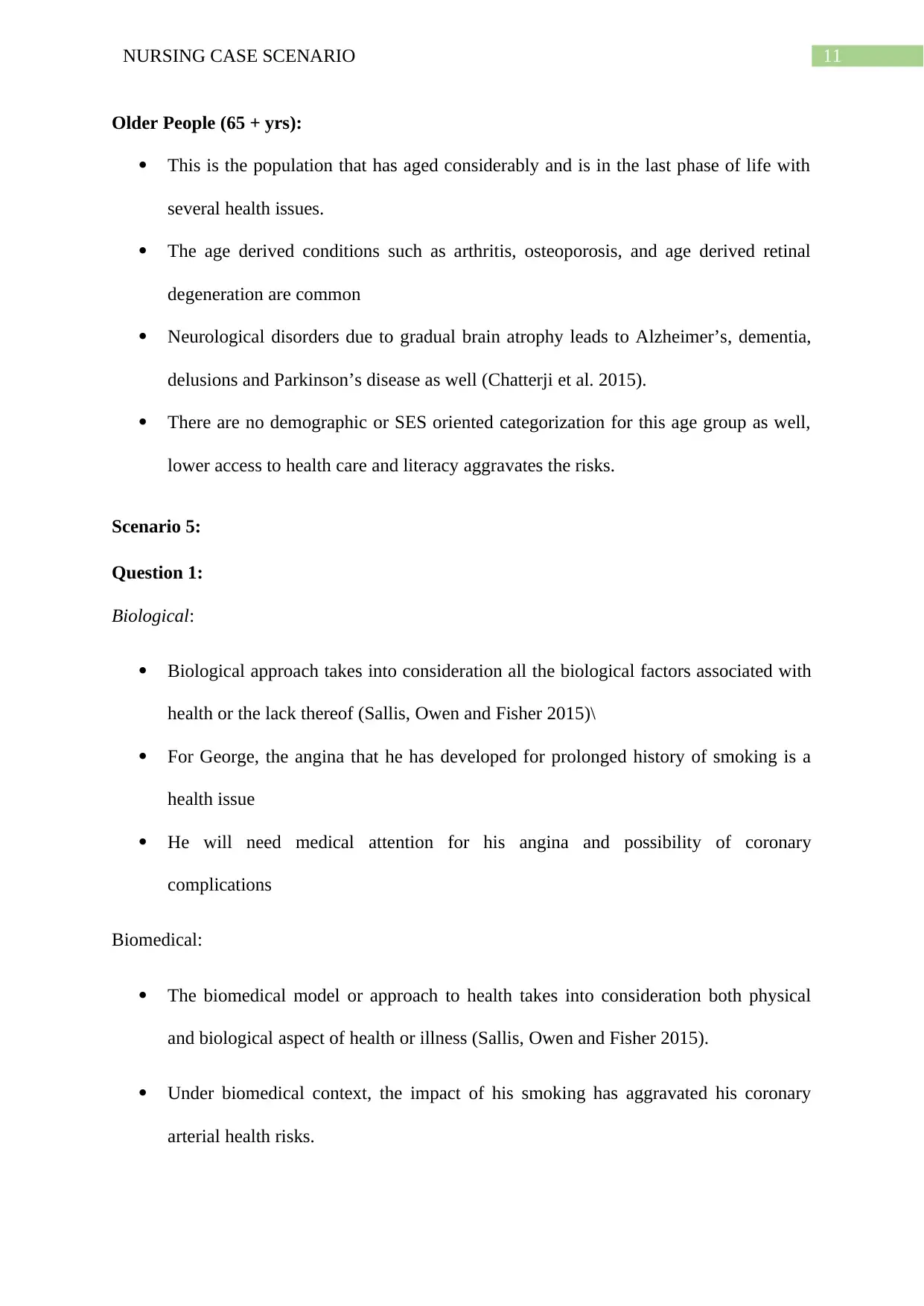
11NURSING CASE SCENARIO
Older People (65 + yrs):
This is the population that has aged considerably and is in the last phase of life with
several health issues.
The age derived conditions such as arthritis, osteoporosis, and age derived retinal
degeneration are common
Neurological disorders due to gradual brain atrophy leads to Alzheimer’s, dementia,
delusions and Parkinson’s disease as well (Chatterji et al. 2015).
There are no demographic or SES oriented categorization for this age group as well,
lower access to health care and literacy aggravates the risks.
Scenario 5:
Question 1:
Biological:
Biological approach takes into consideration all the biological factors associated with
health or the lack thereof (Sallis, Owen and Fisher 2015)\
For George, the angina that he has developed for prolonged history of smoking is a
health issue
He will need medical attention for his angina and possibility of coronary
complications
Biomedical:
The biomedical model or approach to health takes into consideration both physical
and biological aspect of health or illness (Sallis, Owen and Fisher 2015).
Under biomedical context, the impact of his smoking has aggravated his coronary
arterial health risks.
Older People (65 + yrs):
This is the population that has aged considerably and is in the last phase of life with
several health issues.
The age derived conditions such as arthritis, osteoporosis, and age derived retinal
degeneration are common
Neurological disorders due to gradual brain atrophy leads to Alzheimer’s, dementia,
delusions and Parkinson’s disease as well (Chatterji et al. 2015).
There are no demographic or SES oriented categorization for this age group as well,
lower access to health care and literacy aggravates the risks.
Scenario 5:
Question 1:
Biological:
Biological approach takes into consideration all the biological factors associated with
health or the lack thereof (Sallis, Owen and Fisher 2015)\
For George, the angina that he has developed for prolonged history of smoking is a
health issue
He will need medical attention for his angina and possibility of coronary
complications
Biomedical:
The biomedical model or approach to health takes into consideration both physical
and biological aspect of health or illness (Sallis, Owen and Fisher 2015).
Under biomedical context, the impact of his smoking has aggravated his coronary
arterial health risks.
⊘ This is a preview!⊘
Do you want full access?
Subscribe today to unlock all pages.

Trusted by 1+ million students worldwide
1 out of 23
Your All-in-One AI-Powered Toolkit for Academic Success.
+13062052269
info@desklib.com
Available 24*7 on WhatsApp / Email
![[object Object]](/_next/static/media/star-bottom.7253800d.svg)
Unlock your academic potential
Copyright © 2020–2025 A2Z Services. All Rights Reserved. Developed and managed by ZUCOL.